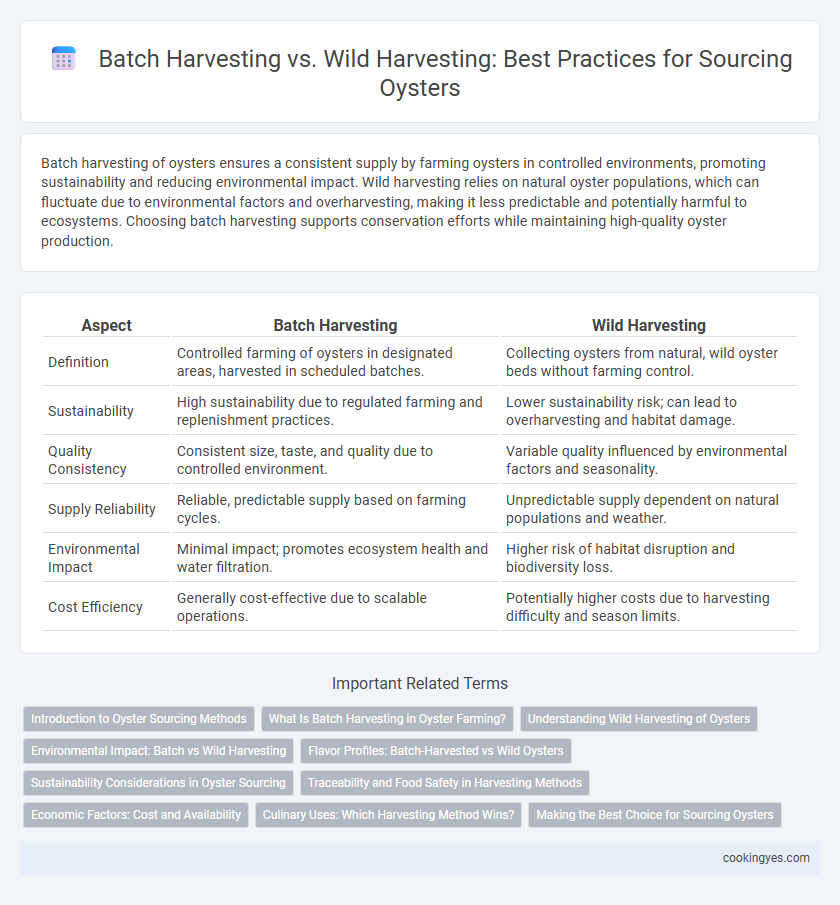Batch harvesting of oysters ensures a consistent supply by farming oysters in controlled environments, promoting sustainability and reducing environmental impact. Wild harvesting relies on natural oyster populations, which can fluctuate due to environmental factors and overharvesting, making it less predictable and potentially harmful to ecosystems. Choosing batch harvesting supports conservation efforts while maintaining high-quality oyster production.
Table of Comparison
| Aspect | Batch Harvesting | Wild Harvesting |
|---|---|---|
| Definition | Controlled farming of oysters in designated areas, harvested in scheduled batches. | Collecting oysters from natural, wild oyster beds without farming control. |
| Sustainability | High sustainability due to regulated farming and replenishment practices. | Lower sustainability risk; can lead to overharvesting and habitat damage. |
| Quality Consistency | Consistent size, taste, and quality due to controlled environment. | Variable quality influenced by environmental factors and seasonality. |
| Supply Reliability | Reliable, predictable supply based on farming cycles. | Unpredictable supply dependent on natural populations and weather. |
| Environmental Impact | Minimal impact; promotes ecosystem health and water filtration. | Higher risk of habitat disruption and biodiversity loss. |
| Cost Efficiency | Generally cost-effective due to scalable operations. | Potentially higher costs due to harvesting difficulty and season limits. |
Introduction to Oyster Sourcing Methods
Batch harvesting involves cultivating oysters in controlled environments such as aquaculture farms where oysters are grown on racks or in cages, ensuring a consistent and sustainable supply. Wild harvesting relies on collecting oysters from natural habitats like tidal flats and estuaries, often requiring careful management to prevent overfishing and ecosystem disruption. Both methods impact oyster quality, sustainability, and market availability, making informed sourcing choices critical for seafood businesses.
What Is Batch Harvesting in Oyster Farming?
Batch harvesting in oyster farming involves raising oysters in controlled environments where they are collected at specific growth stages to ensure uniform size and quality. This method allows precise management of water conditions, feeding, and disease control, leading to higher yields and consistent product standards. Unlike wild harvesting, batch harvesting supports sustainable oyster populations by reducing environmental impact and overharvesting in natural habitats.
Understanding Wild Harvesting of Oysters
Wild harvesting of oysters involves collecting oysters directly from their natural habitats such as tidal creeks, estuaries, and coastal waters, ensuring they are naturally filtered and matured in rich, nutrient-filled environments. This method maintains ecological balance while providing oysters with diverse flavors influenced by their unique surroundings, often appealing to consumers seeking authentic, fresh seafood. Sustainability challenges arise from overharvesting and environmental changes, necessitating careful management to protect oyster populations and maintain ecosystem health.
Environmental Impact: Batch vs Wild Harvesting
Batch harvesting of oysters generally has a lower environmental impact compared to wild harvesting, as it involves controlled farming practices that reduce habitat disruption and promote sustainable water quality management. Wild harvesting can lead to overfishing, habitat degradation, and biodiversity loss in natural oyster beds due to unregulated extraction. Sustainable batch harvesting supports ecosystem restoration by maintaining oyster populations and enhancing water filtration, crucial for coastal marine environments.
Flavor Profiles: Batch-Harvested vs Wild Oysters
Batch-harvested oysters typically present a consistent, mild flavor profile with subtle briny and sweet notes due to controlled growing environments and uniform feeding schedules. Wild-harvested oysters offer a more complex and varied taste, often described as robust and mineral-rich, reflecting the dynamic natural waters and diverse plankton diets where they thrive. Flavor differences hinge on habitat, salinity, and diet, making wild oysters prized for their distinct terroir while batch-harvested oysters are favored for reliability in taste and texture.
Sustainability Considerations in Oyster Sourcing
Batch harvesting of oysters involves controlled collection cycles that help maintain population balance and reduce habitat disruption, promoting sustainable aquaculture practices. Wild harvesting, while often perceived as traditional, can lead to overfishing and ecosystem damage if not managed with strict regulations and monitoring. Sustainable oyster sourcing prioritizes methods that minimize environmental impact, support biodiversity, and ensure the long-term viability of oyster populations.
Traceability and Food Safety in Harvesting Methods
Batch harvesting offers enhanced traceability by allowing precise tracking of oyster origin, harvest date, and environmental conditions, thereby ensuring consistent food safety standards. In contrast, wild harvesting presents challenges in traceability due to variable sourcing and potential exposure to uncontrolled pollutants, increasing the risk of contamination. Implementing batch harvesting methods strengthens supply chain transparency and minimizes foodborne illness risks associated with oyster consumption.
Economic Factors: Cost and Availability
Batch harvesting oysters involves controlled environments that ensure consistent supply and lower long-term costs through optimized growth cycles and reduced mortality rates. Wild harvesting depends on natural oyster populations, resulting in variable availability and higher labor expenses due to unpredictable yields and environmental factors. Economically, batch harvesting offers more stability and scalability for commercial oyster sourcing compared to the fluctuating costs and limited supply of wild harvesting.
Culinary Uses: Which Harvesting Method Wins?
Batch harvesting oysters ensures consistent quality and size, ideal for precise culinary preparations such as raw bars, grilling, and delicate sauces, enhancing flavor uniformity and presentation. Wild harvesting offers oysters with varied taste profiles influenced by diverse natural habitats, enriching dishes that benefit from unique briny and mineral notes, preferred in gourmet recipes emphasizing regional terroir. Chefs often prefer batch-harvested oysters for reliable texture and flavor, while wild-harvested oysters are prized for distinctive character, making the choice dependent on the desired culinary experience.
Making the Best Choice for Sourcing Oysters
Batch harvesting offers consistent oyster quality and controlled environmental conditions, reducing contamination risks compared to wild harvesting. Wild harvesting provides naturally matured oysters with unique flavor profiles influenced by diverse marine ecosystems, appealing to connoisseurs seeking authenticity. Choosing the best oyster sourcing method depends on balancing reliability, flavor preferences, and sustainability considerations for optimal seafood quality.
Batch Harvesting vs Wild Harvesting for oyster sourcing Infographic

 cookingyes.com
cookingyes.com